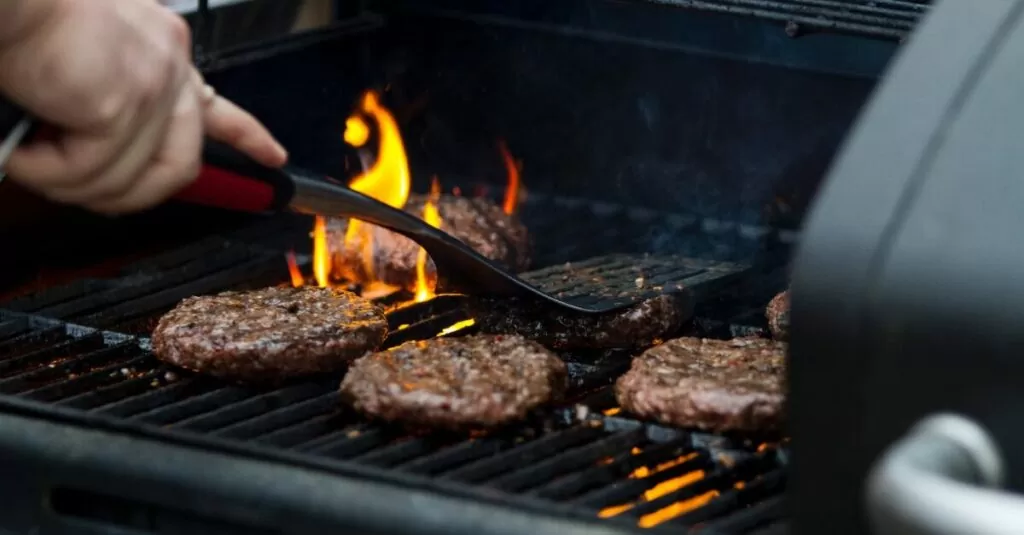An outdoor fire pit is one of life’s simple pleasures. Gathering around the mesmerizing glow and flames with loved ones creates lasting memories. But first, you must select the optimal fuel for sparking your perfect patio fire experience and keep your flames burning bright, all through the night.
From classic wood to convenient gas options, many factors impact your outdoor fire pit fuel decision. This definitive guide by Patio Productions covers everything you need to know – from costs and benefits to safety and environmental impact.
Read on to ignite your fire pit fuel knowledge and discover the ideal options to match your needs. Let’s explore the fuels that allow you to bring life outdoors, with exceptionally cozy patio living all season long, day or night.
Wood – The Traditional and Most Common Fuel
Natural wood remains the most widely used fuel for outdoor fire pits. Over 80% of outdoor fire pits run on wood, and for good reason. The nostalgic crackling sound, campfire aroma, and active flame movement create a fantastic natural ambiance. Wood fire pits themselves are also less complicated and usually cheaper than gas and gel pits, though the fuel itself can be more expensive in the long run.
Benefits of Wood
- Provides an authentic campfire experience with sensory pleasures
- Inexpensive and accessible fuel for most homeowners
- Burns a long time, especially dense hardwoods like oak
- Controllable flame height by adjusting log size and volume
Considerations for Wood
- Labor-intensive preparation like chopping and stacking
- Generates smoke and embers that may bother some
- Risks like flying sparks if left unattended
- Restricted in many urban areas due to air quality concerns
- Can be less efficient and potentially more expensive than other options, depending on your access to firewood.
For maximum sensory nostalgia, choose seasoned hardwoods over softwoods. Avoid wet or rotting logs which smolder excessively. With basic safety practices, wood can be the perfect natural fuel for backyard bonfires.
Propane – Convenient and Portable
Propane offers excellent convenience and portability for outdoor fire pits. Tanks make it easy to move the unit anywhere on your patio. Just push a button to ignite the instant flames.

Benefits of Propane
- Push-button ignition eliminates messy fire building
- Portable tanks offer flexibility in placement
- Adjustable warmth and height through a control knob
- Burns cleaner than wood with less smoke and ash
- Various styles, from portable bowls to extravagant tables
Potential Drawbacks of Propane
- Refilling tanks regularly can get costly
- Does not replicate the scent of real wood fires
- Tank storage/swap out requires space when not in use
- Gas odor bothers some people
For ease of use and maintenance, propane leads the pack. Enjoy patio ambiance instantly with the push of a button and no wood prep is needed!
Click here to view our propane fire pits
Natural Gas – Endless Flames from Home Pipeline
Connecting your permanent outdoor fire pit to your home’s natural gas line provides exceptional convenience. By tapping into your existing gas supply, you’ll enjoy unlimited instant fires with the flip of a switch.

Benefits of Natural Gas
- Hooks directly into your home’s existing gas pipeline
- Avoids propane tank hauling, storage, and refilling
- Often cheaper long-term than refilling propane
- Instant on/off convenience with the turn of a key
- Emits no smoke, only clean flames
Potential Drawbacks of Natural Gas
- Professional installation is required to connect to the gas line
- Limits placement to patio areas near the home’s gas supply
- Gas line leaks pose a risk if pipes become damaged
For endless patio ambiance with zero hassles, a natural gas fire pit is unbeatable. Enjoy maintenance-free flames conveniently burning all evening long.
Click here to see our natural gas models
Gel Fuel – Portable and Eco-Friendly
Smokeless, odorless gel fuel offers a top eco-friendly choice for portable outdoor fire pits. The methanol-based gel burns cleanly and evenly right from the disposable canister.
Benefits of Gel Fuel
- Leaves no smoke, ash, or post-use cleanup
- Canisters make gel highly portable for travel
- Provides consistent, even heat output
- Models available without electricity
Potential Drawbacks of Gel Fuel
- Refueling gel canisters carries ongoing costs
- Limited 2-6 hour burn time per canister
- Risk of formaldehyde exposure if ventilation is poor
For maximum safety and portability, smoke-free gel fuel checks all the boxes. Those prioritizing a clean, mess-free patio fire will love the simplicity of gel (and here’s 8 more things to think about when shopping for fire pits)
Wood Pellets – An Efficient Wood Fuel Alternative
For wood-burning fire pit fans seeking added convenience, wood pellets offer an efficient fuel option. Made from compressed sawdust and wood waste, pellets provide extended burn times with reduced mess and emissions.
Benefits of Wood Pellets
- Dense compressed pellets provide more efficient fuel than logs
- Produce less ash and smoke due to high density
- Burn hotter and longer than typical cordwood
- Require less storage space than logs
Potential Drawbacks of Wood Pellets
- Still produce some smoke, though less than cordwood
- Special pellet-burning fire pits required
- Can be more expensive than cordwood
Wood pellets combine the ambiance of real wood with the convenience of condensed fuel. For less smoke and longer burn times with reduced mess, they provide an excellent wood fuel option.
Firelogs – A Wood Burning Alternative
For wood fire fans seeking less mess and emissions, compressed firelogs offer a nice middle ground. Made from recycled sawdust and materials, firelogs burn longer and cleaner than cordwood.
Benefits of Firelogs
- Dense logs burn up to 30% longer than typical cordwood
- Made from recycled sawdust and waste materials
- Easy stacking and storage, unlike loose firewood
- Reduced emissions and smoke output
Potential Drawbacks of Firelogs
- Still emit some smoke, though less than cordwood
- Don’t replicate the full ambiance of real wood fires
- Not as eco-friendly as non-wood fuel options
For those who love the smell of a real wood fire, firelogs offer a nice hybrid option – enhanced burn performance without the labor of wood prep.

How To Pick The Best Fuel Type for Your Needs
With the range of outdoor fire pit fuel options available, how do you select the right one based on your priorities? Here are some key factors to consider:
- Mess – Wood makes the most cleanup, while gas options are cleanest.
- Emissions – Wood, charcoal, and firelogs still emit smoke particles. Gas, gel and ethanol options burn cleanest.
- Safety – Gel, gas, and ethanol minimize fire risks. Supervise children around any open flames.
- Convenience – For push-button simplicity, gas fuels excel while wood takes more effort.
- Portability – Gel and propane tanks allow taking fire pits camping or to gatherings.
- Cost – Wood is the cheapest for fuel, while propane and gel refills add up over time.
Match your preferences to the fuel’s strengths – smell, convenience, portability etc. For example, if you want convenience but prefer a real wood aroma, propane with lava rocks could be the perfect fit.
Fire Pit Fuel Comparison Chart
| Fuel Type | Burn Time | Smoke | Safety | Convenience | Portability | Cost |
|---|---|---|---|---|---|---|
| Wood Pellets | 6-8 hrs | Low smoke | Low risk | High convenience | Medium | Moderate fuel cost |
| Wood | 2-6 hrs | High smoke | Risk of sparks | Labor intensive | Low | Cheap fuel, spendy setup |
| Propane | Variable | Low smoke | High safety | Push button | High | Moderate recurring fuel cost |
| Natural Gas | Variable | No smoke | Very safe | Push button | Not portable | Cheap long-term fuel cost |
| Gel Fuel | 2-6 hrs | No smoke | High safety | Simple | High | Moderate recurring fuel cost |
| Firelogs | 3-4 hrs | Medium smoke | Medium safety | Easy stacking | Low | Cheaper than wood |
This comparison summarizes the key factors to weigh when deciding between wood, propane, natural gas, gel fuel, firelogs, and more for your ideal outdoor fire pit fuel.

Critical Safety Tips for Outdoor Fire Pits
While fire pits spark joy, safety should always come first, given the risks of open flames. Follow these tips:
- Place portable units on non-flammable surfaces at least 15 feet from structures. Avoid wooden decks.
- For permanent installs, maintain 15-20+ foot clearance from buildings, trees, and fences.
- Never leave a burning fire pit unattended, especially around children. Provide attentive adult supervision.
- Install a spark screen to contain embers and prevent flying sparks.
- Keep a fire extinguisher or hose nearby and teach kids proper safety protocols.
With prudent safety practices, your outdoor fire pit will provide years of special memories on the patio! Please always err on the side of caution around the beauty and dangers of fire.
Maintaining Your Fire Pit for Maximum Enjoyment
Like any patio product, periodic fire pit maintenance optimizes safety, appearance and longevity. Follow these tips:
Wood-Burning Fire Pit Care
- Remove ashes regularly and check for damage needing repair.
- Consider weather sealing or oiling the wood to prevent rot over time.
- Keep covered when not in use to protect from heavy rain.
Gas and Gel Fuel Fire Pit Upkeep
- Keep burner area and ventilation ports clear of obstructions.
- Check fuel lines, valves, and seals for any leaks requiring replacement.
- Wipe down the exterior periodically with a soft cloth and mild detergent.
With proper care, your well-maintained outdoor fire pit will serve as a beloved gathering place for years on end!
The Perfect Backyard Fire Starts With the Ideal Fuel
In closing, while wood may provide supreme sensory nostalgia, modern gas fuels offer convenience and safety benefits. Propane gives the simplicity of push-button flames but still allows a crackling ambiance with lava rock fillers. For permanent installs, natural gas delivers unlimited instant fires.
And eco-friendly smoke-free options like gel fuel offer their own advantages as well. With the range of fire pit fuel types available, you’re sure to find one that ignites your perfect backyard blaze.
We hope this definitive outdoor fire pit fuel guide by Patio Productions provides facts to inform your purchasing decision. Please fire responsibly and make safety your top priority. Stay cozy, gathering around the mesmerizing glow – the memories will burn brightly for years to come!

Frequently Asked Questions about Patio Fire Pit Fuels
What is the most popular fuel for outdoor fire pits?
Wood remains the most popular fuel, used in over 80% of outdoor fire pits. It provides a nostalgic aroma and campfire ambiance.
Which fuel is best for convenience and ease of use?
Propane and natural gas offer the ultimate convenience. With instant push-button ignition and adjustable heat, gas fire pits require no messy fire prep.
What is the most portable fire pit fuel option?
Gel fuels shine for portability thanks to their mess-free, smokeless operation from disposable canisters. Propane tanks also allow taking fire pits camping or to events.
Which fuel option is the most eco-friendly?
Natural gas, propane, and gel fuel offer the cleanest operation with less smoke and emissions than wood. For a renewable option, bioethanol is an eco-friendly choice.
What fire pit fuel is the most economical?
Wood is the cheapest direct fuel cost, though pricier setups are required. Natural gas is the cheapest overall since it utilizes your existing home gas line.
How do I know which fuel is right for my needs?
Consider your priorities in terms of features like convenience, portability, cost, safety, ambiance, and environmental impact. Then match fuel options to your needs.
What precautions should I take with outdoor fire pits?
Exercise extreme care with placement, ignition, supervision, and extinguishment around any open flames. Never leave a fire unattended and keep children and pets at a safe distance.
Hopefully, these common questions help provide a useful overview of the key factors to weigh when choosing fire pit fuels. Please reach out to with any other questions!
Video Summary

Todd is a co-owner of Patio Productions and has worked extensively in the furniture industry since 2002, when he started a company that designed and manufactured bathroom vanities. He now has a hand in all online business operations, including keeping tabs on industry trends and making sure Patio Productions remains an innovative leader in the outdoor furniture space. He lives just outside of Denver, Colorado with his wife, two boys, and two dogs. They live on a lake where they can make the most of the outdoor lifestyle. His favorite patio furniture sets are his Harmonia Living sectionals.










